January 2015
Skills in a Flash!
Take advantage of all the little “teachable times” in your school day with these games. Keep flashcards handy for when you have a few extra minutes before lunch, as children wash hands, or while waiting for the bell to ring. One teacher suggested storing them in a sand bucket on your desk. Make a different set of flashcards every few weeks that focus on specific skills your students need to master.
Hint! Make flash cards from circles (paper plates work well) rather than rectangles. Circles tend to pull the eyes to the middle rather than the corners.
Jumbo craft sticks can also be used to make flashcards.

BOOM!
Write “BOOM!” with a bright marker or glitter pen on several of the flashcards. As you “flash” through the cards, children identify the information. When “BOOM!” appears, children jump up and shout out “Boom!”

•Change the surprise word for different holidays and seasons. In January use a snowman sticker and write “Brrrr!” The children stand up and pretend to shiver when it appears.
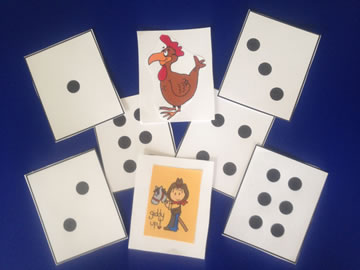
•Another fun version is “cowboys” and “chickens.” Insert pictures of a few cowboys and a few chickens. When the cowboy appears the children stand up and pretend to twirl a lasso. When the chicken appears they stand up and flap their arms and cluck.
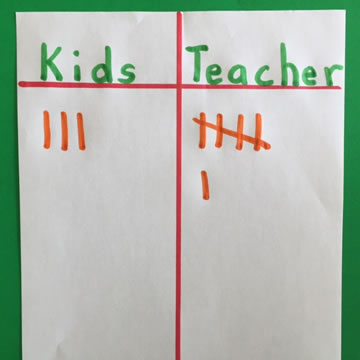
Kids vs. Teacher
Draw a T chart on the board with “Kids” on one side and “Teacher” on the other side. Hold up a flash card. If a child raises her hand and correctly reads the word, she gets a point for the “kids.” If any child shouts out the answer, then the teacher gets a point.
(If children keep talking out of turn, just continue to give points to the teacher. They’ll figure it out!)
Secret Sticker
Arrange flash cards in a pocket chart or on the floor. Tell the children to close their eyes as you hide a sticker behind one of the flash cards. “Who knows where the sticker is hidden?” One at a time children identify the word or other information on a flash card and turn it over. The first child to find the sticker gets to be “teacher” and they get to hide the sticker again.
•Change this game each month with a different seasonal sticker.
Knock! Knock!
Place flash cards face down in a pocket chart or on the chalk tray. Pretend to knock on one card at a time as you say, “Knock! Knock!” Children say, “Who’s there?" Turn over the card as children say, “It’s….” and identify the information
Tisket Tasket
Children sit or stand in a circle. Place flash cards in a basket and choose one child to be “it.” “It” skips around the room as everyone sings:
A tisket, a tasket, there are words in the basket.
I’ll place a word behind a friend
And see if they can read it.
“It” drops a word behind a friend. The friend reads the word and then trades places and becomes “it.”
Shine On
Have children take a flashlight and shine on words as you sing this song to the tune of “This Little Light of Mine”:
This little light of mine,
I’m going to let it shine.
Shine on (word), (word), (word).
 Swat It
Swat It
Children take a fly swatter and say this rhyme as they swat the word (letter, numeral, etc.) on the word wall, alphabet chart, hundreds chart, etc.
There’s a word I see.
Swat the word ____.
One, two, three!
• A variation of this game can be played by dividing the class into two teams. Give one person from each team a fly swatter. Call out a word. The first person to “swat” the word wins a point for her team.
Stomp
Place the flash cards randomly on the floor in the middle of the room.
Divide the class into two teams. Choose one child from each team to come up and play.
Call out a word.
The first child to stomp on it wins a point for their team.
Pick Up
This game is similar to stomp. The teacher calls out a word and the first child to pick it up wins a point for their team.
Around the World
Children sit in a circle. One child (it) stands behind the first child in the circle. The teacher holds up a flash card. The first one to identify it moves and stands behind the second child in the circle. The object is to see who can go all “around the world.”
Snowballs
Each child takes a sheet of scrap paper and writes a word wall word, spelling word, math fact, etc. on it. Children wad up their sheet of paper to make it a “snowball.” Divide the class into two teams and have them stand about 20 feet from each other. When the teacher says, “Let it snow!” children begin throwing their snowballs at the opposite side. Children pick up a snowball and identify the information on it before throwing it back at the other side. The game continues until the teacher says, “Freeze!” Count the number of snowballs on each side.
Who
has more? Who has less? In this game, the team with the smaller amount is actually the winner! Everyone gets another snowball and the game continues.
•At the beginning of the school year, have children write their names on snowballs and play the game. It’s a great way to get acquainted with classmates.
•As a study review, have children write questions on the snowballs. When children open them they must answer the question before throwing it again. Remind the children that if they don’t know the answer, it’s O.K. to ask a friend for help.
Sparkle
Children stand or sit in a circle. The teacher calls out a high frequency word or spelling word. The first child says the first letter in the word. The second child says the second letter and so on around the circle until the word is spelled. The next child says, “Sparkle!” and then the next child has to sit down. Continue until there is only one child standing.
Word Bag
Students sit in a circle. Have a “word bag” with lifetime words. As you pass the bag around, each student pulls out a word. They can keep the card if they can read the word. Keep passing the bag until it is empty.
Rules! If you talk, give answers, or blurt out, the teacher takes away all of your cards and you don’t get to have any more fun!
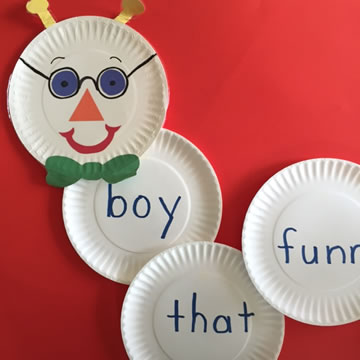
Word Worm
Draw the face of a worm on a 9” circle. Pass out a word card to each child. One at a time children come up and place their word next to the worm’s head. Each child reads all of the previous words before placing her word down. How long can the worm grow?
Note! Children can “ask the audience” to read with them if they are unsure of the words.
I Have. Who Has?
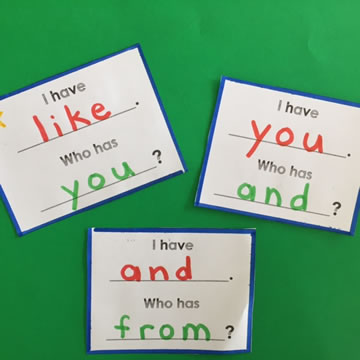
Make copies of cards similar to the one shown with “I have____. Who has____?” on them. Write words you are focusing on so that the game will flow from one word to the next. Draw a star on the first card and then pass give one to each student. The first child stands and says, “I have word one. Who has word two?” The second child says, “I have word two. Who has word three?” The game continues as children read their words.
•Seal envelopes and then cut them in half to make puppets. Write a different letter of the alphabet on each half. Mix up the letters and pass them out. The child with “A” stands and says, “I have A. Who has B?” The child with “B” says, “I have B. Who has C?” and so forth.
•Write numerals on envelope puppets and use for counting.
Mingle
Children quietly tiptoe around the room until the teacher calls out a number. They must then form groups of that amount. Those who can’t find a group can cluck like chickens, do jumping jacks, or do another silly movement. Continue having children mingle and form groups of different amounts.
BINGO
Make BINGO cards with high frequency words. Give children cereal or other small objects to cover up words as they are called out.

Hint! Baseball cardholders are great for this activity because they can be changed throughout the year as you focus on different skills.
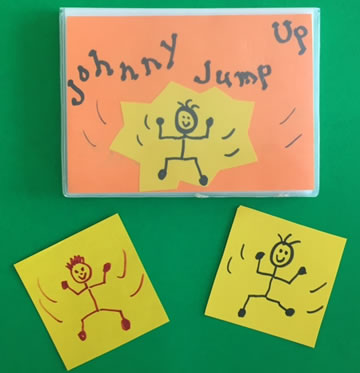
Johnny Jump Up
You will need a photo album and index cards to make this game. Write words on the index cards and insert them in the plastic sleeves. On several cards draw a stick figure jumping and write, “Johnny jump up!” Randomly insert the Johnny cards in the album. As you shuffle through the book children read the words. When Johnny appears they all jump up and shout, “Johnny jump up!”
Word Detectives
Let children be “detectives” as they listen to clues about different words. Hints might include: “This word rhymes with ______.” “This word starts with letter and ends with letter.” “This word is the opposite of _______,”
•You can also ask the children to close their eyes. Cover up one word on the word wall with a sheet of paper. Can they identify the missing word? (You can also cover up numerals on the hundreds chart or letters on the alphabet.)
UNO
Cut poster board into 3” x 4 ½” cards. Take high frequency words you are working on and write each word 4 times in red, black, green, and blue. Deal out seven cards to each child. The first child lays down a card. The next player may lay down that same word or another word in the same color. The game continues just like UNO until all cards are gone.
Next Page




 Swat It
Swat It


